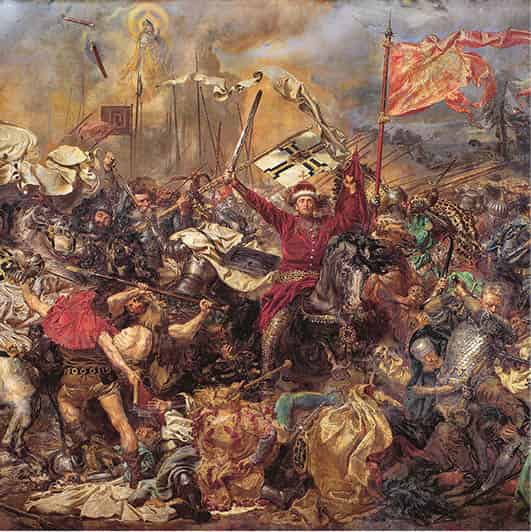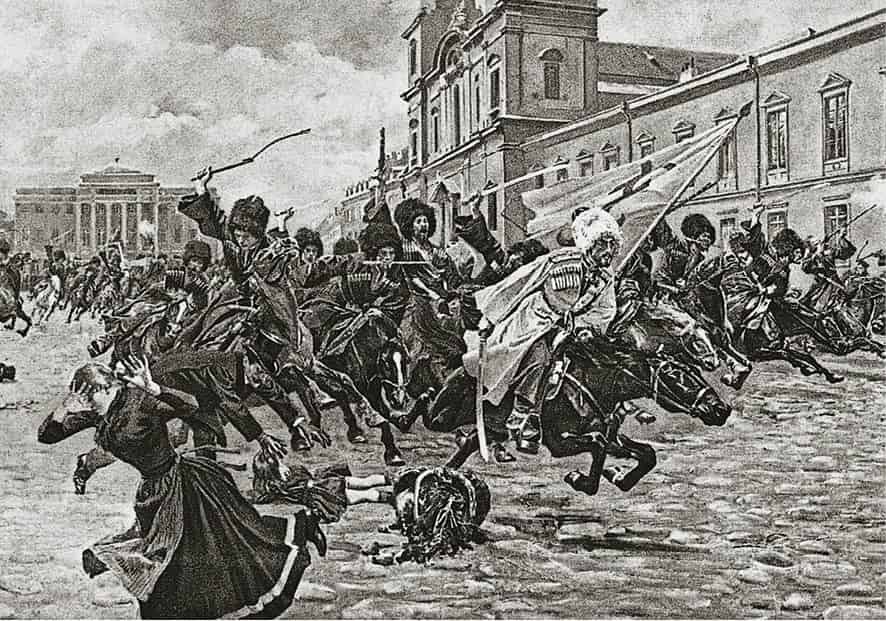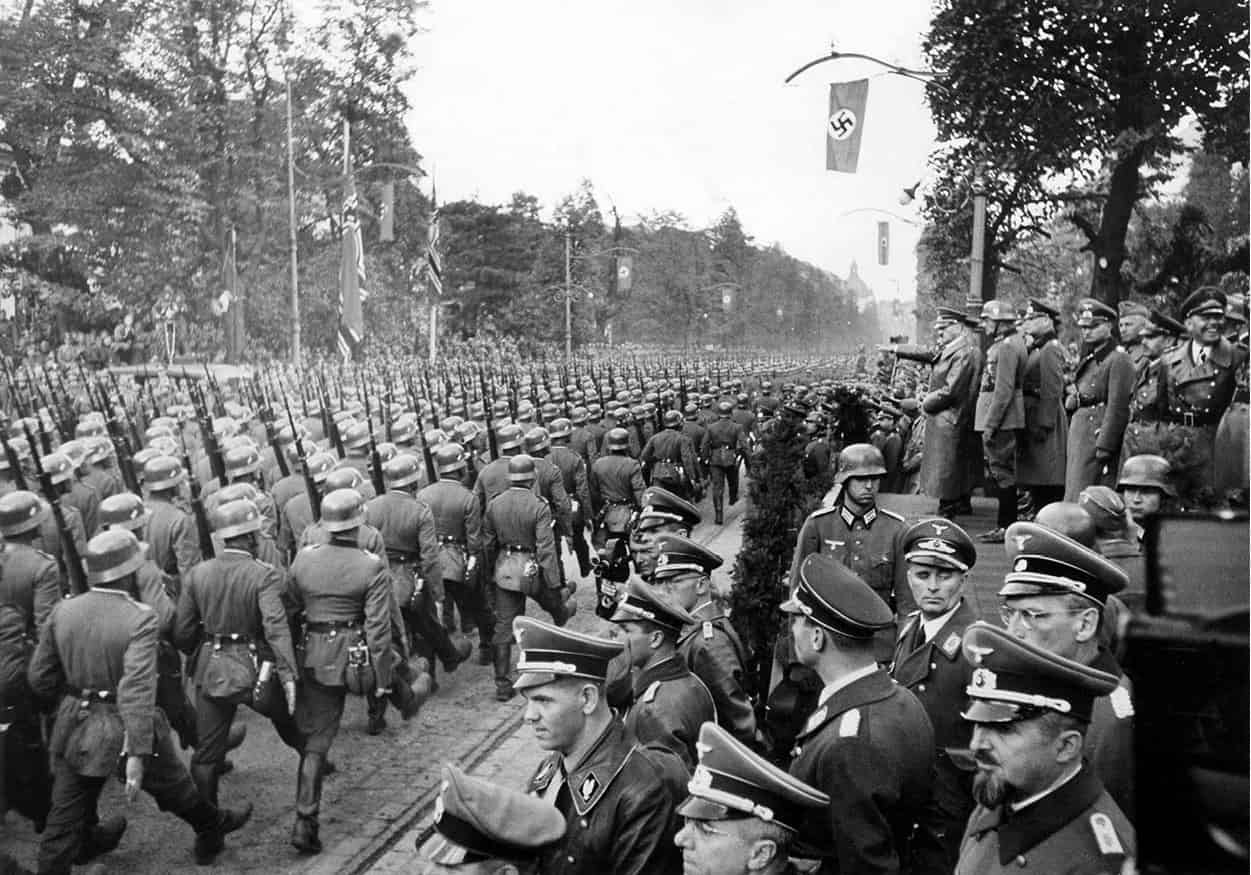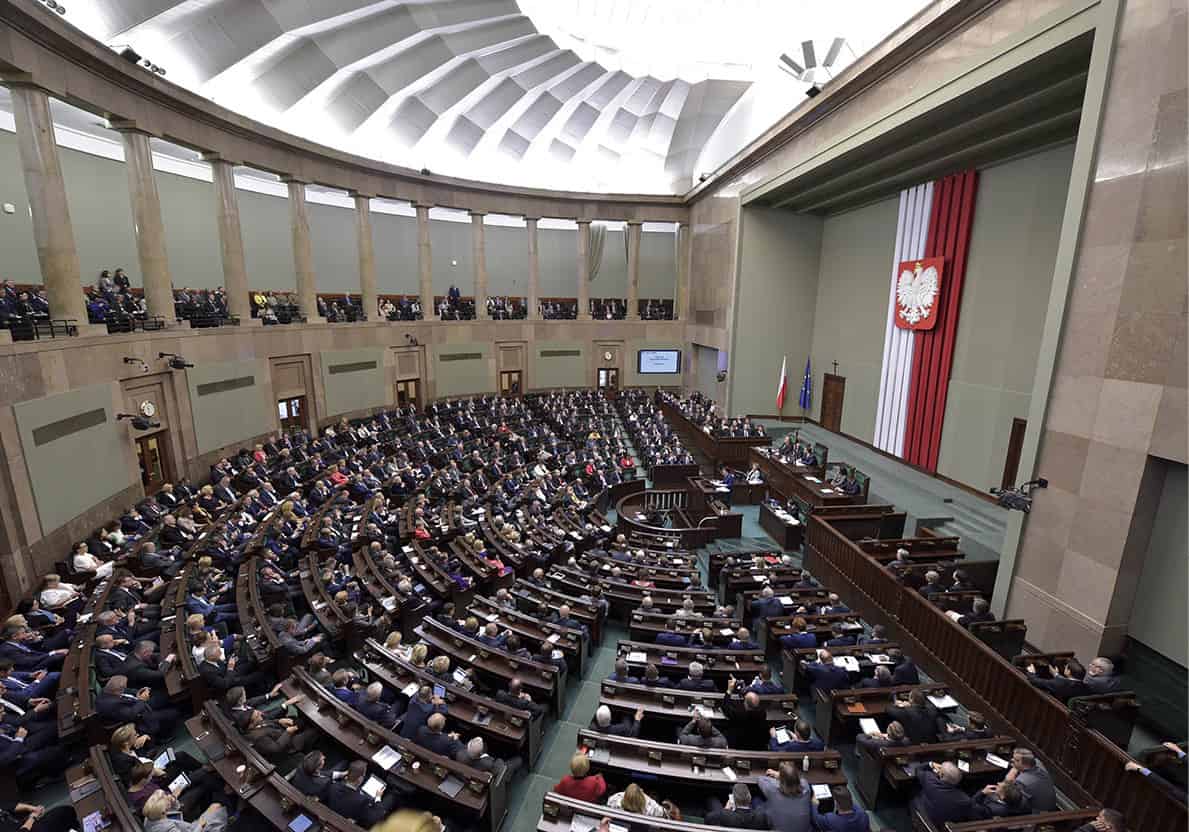Poland’s war-torn, almost incomprehensibly fractured history plays out like an epic novel – occasionally triumphant, frequently sad and tragic. Over a millennium, Poland evolved from a huge, economically powerful kingdom to a partitioned nation that ceased to exist on world maps for over 120 years, and finally to a people and land at the centre of the 20th century’s greatest wars and most horrific human tragedies. But Poland has survived, with its culture, language and most of its territory intact, and today Poles, who entered into the European Union (EU) in 2004 and NATO in 1999, are taking their place at the forefront of post-Communist Central Europe.
Foundations of the Polish State
The region that would become Poland, a great plain sandwiched between the Wisła (Vistula) and Odra (Oder) rivers, has been inhabited since the Stone Age by migratory tribal peoples – among them Celts, Balts, Huns, Slavs and Mongols. Tribal culture reigned, untouched by the more sophisticated civilisation of the Roman Empire. Slavic tribes arrived by the 8th century AD and put down roots; the Ślężanie, Mazowszanie, Pomorzanie and Wiślanie peoples inhabited much of the territory. The Polonian tribe, which settled the area that today is western Poland around Poznań, provided the foundations for the development of a Polish language and nation.
Prince Mieszko, leader of the Piast dynasty that ruled the Polonians, undertook the bold step of unifying the Polanie and neighbouring tribes. Mieszko adopted Christianity – probably an astute political move to place the new state on equal footing with nearby Christian states with ties to Rome – and married a Czech princess, Dobrawa, in 965. His religious conversion won him the support of the papacy, and Mieszko effectively founded the Polish state the following year. By the end of the 10th century, he had united his tribal territory, Wielkopolska (Great Poland), with that of another tribe, Małopolska (Little Poland) – regional names that remain in use today. Silesia, settled by a different tribe, would eventually become the third component of the nascent Polish state.
What’s in a name?
The Polanie tribe (the Polonians), who lived in the Warta valley not far from Poznań, may have been the people who gave Poland its name. Polanie means ‘of the fields’.

Stained-glass window, Franciscan Church, Kraków
Gregory Wrona/Apa Publications
Mieszko’s son Bolesław ‘The Brave’ was acknowledged by Otto III, the Holy Roman Emperor. Bolesław later repelled invasions from Otto’s successor and then sought Poland’s own expansion eastwards; he eventually annexed parts of present-day Ukraine. The Pope recognised Bolesław as the first king of Poland in 1025, elevating the country to full membership in a European community of Christian states.
Inbetween several often short, troubled and feuding reigns, Kazimierz I ‘the Restorer’ put the country on a firm footing again and established his court in Kraków. Kraków grew in importance and became the country’s capital, replacing Gniezno in 1038. Kraków was better positioned for trade and also less vulnerable to attacks from the Czechs and Germans. Helped by the arrival of immigrants from all over Europe, including thousands of Jews, Kraków became a prosperous and culturally enriched capital.
From the mid-13th century, Tartars invaded Poland on three occasions. Threatened by the Prussians, Duke Konrad of Mazovia invited in the Order of the Teutonic Knights to help defend against them. The Knights used their considerable military might to then assume control of the very territory they had helped defend, capturing Gdańsk, securing most of the Baltic region and cutting off the rest of Poland from access to the sea. The Tartars defeated the Poles at the Battle of Legnica in 1241 and destroyed most of Kraków, leaving only the castle and St Andrew’s Church intact.
The Teutonic Knights
The Teutonic Knights were a military order of German knights who served in the Holy Land. They played an important part in Polish history, originally acquiring their prosperity through gifts of land for their hospital work during the Crusades. They were also given land in northeast Poland in 1225 in return for assisting the Mazovian Duke Konrad to repel an invasion of pagan Prussians. After annexing this Prussian territory, they gradually extended their occupation, invading Polish towns such as Gdańsk in the early 14th century and slaughtering the inhabitants, until their incursions were finally repulsed by the joint Polish-Lithuanian Commonwealth, and the knights were defeated in 1410 at the Battle of Grunwald. Malbork Castle (for more information, click here), established as the headquarters of the Knights’ grand master, was taken over by the Poles in 1457 and the grand master swore allegiance to the Polish king.
Kazimierz the Great and the Jagiellonians
The last king of the Piast dynasty, Kazimierz III, the Great, succeeded in reunifying Poland. His rule ushered in Poland’s first golden age. Kazimierz built great castles and towns, codified laws, and created an entire administrative system of governance for the war-torn country. He rebuilt Kraków with magnificent architecture and established the country’s first university there. Kazimierz, a pragmatist, did not try to wrest control of Silesia, in the hands of Bohemia, or the territory seized by the independent state of the Teutonic Knights. Instead, he consolidated the state by expanding eastwards and accepting minority populations, including persecuted Jews from across Europe, into the predominantly Catholic nation.

Malbork Castle
Shutterstock
Kazimierz’s death in 1370 left the crown to his nephew, Louis of Anjou, the King of Hungary. One of his daughters, Jadwiga, succeeded Louis in Poland, while the other assumed control of Hungary. Jadwiga’s 1385 marriage to Władysław Jagiełło, the Grand Duke of Lithuania, led to Poland’s strategic alliance with that powerful country. Following his wife’s death, Jagiełło ruled both Poland and Lithuania for just shy of half a century, establishing a dynasty that would remain in power until 1572. The united countries defeated the Teutonic Knights at the Battle of Grunwald in 1410, halfway between Warsaw and the Lithuanian border, and repelled Germanic eastward expansion. The Thirteen Years’ War yielded great benefits for Poland: the transformation of Danzig (Gdańsk) into an independent city-state under the protection of the Polish crown and the capture of other Knights’ territories.
Polish nobles saw their political might expand in the early Renaissance with the king’s ‘rule of the nobility’, which granted exclusive right to enact legislation to nobles in the parliament, or Sejm. The 1500s saw prosperity, power and cultural and scientific achievement for the Polish-Lithuanian Commonwealth. Just before his death in 1543 Mikołaj Kopernik (Nicolaus Copernicus), born in Toruń and a graduate of the Jagiellonian University in Kraków, published his groundbreaking treatise, De Revolutionibus Orbium Coeliestium, which stated that the sun and not the earth is the centre of the universe. Although the Reformation and Lutherism had an impact on Poland, the country largely avoided the devastating religious wars that raged elsewhere in Europe.
The Sejm moved to Warsaw in 1529, and the death of the last ruler of the Jagiellonian dynasty, Zygmunt August, led to the creation of a Republic of Nobles and an elective monarchy that would serve it. Warsaw, better located in the centre of the country, became the official capital in 1596. King Zygmunt Waza (Sigismund Vasa) moved there from Kraków in 1609.

Battle of Grunwald, Jan Matejko
Public domain
Swedish Dynasty
Three successive elected kings emerged from the Swedish Waza dynasty. Sweden had become the strongest military power in Europe after the Thirty Years’ War and in the mid-17th century the country set its expansionist sights on Poland. The Swedes invaded Poland in 1648, an event labelled the Swedish Deluge in Polish history books. The devastating war lasted five years, during which time Sweden was able to capture most of Poland. The war and the disastrous effects of the plague decimated the population of Poland, reducing it to just 4 million, roughly half its total in the early 17th century.
Remarkably, Poland retained enough military might to repel the Ottoman Turks in their advance through the Balkans. The military leader Jan Sobieski defeated Turkish troops at the Battle of Chocim in 1673, and Sobieski would later be credited with saving Vienna from Turkish forces . Sobieski was elected king of Poland in 1674, but his attention to battles against the Turks at the expense of domestic affairs did not bode well for him and Poland.
Decline and Partitioning
At the start of the 18th century, Poland entered a prolonged period of decline, marked by financial ruin, a debilitated army, and a series of ineffectual kings. Poland was transformed into a client state of the Russians, and then lost much of its western territory to the Prussians during the Silesian Wars that ended in 1763. The following year Stanisław August Poniatowski was elected the last king of the Polish-Lithuanian Commonwealth, and Poland soon faced one of its most humiliating episodes.
The powerful Prussians came up with a plan to partition Poland, which gained the support of the Russians. The imposed treaty in 1772 robbed Poland of nearly a third of its lands. Yet Poniatowski recovered to preside over a reform movement that precipitated the creation of the 1791 Constitution, which restored the hereditary monarchy and overhauled Poland’s political system. The liberal constitution, the oldest in the modern world after that of the United States, provided for the separation of powers among legislative, judicial and executive branches of the government.
None of these reforms pleased the Russians and Prussians, who continued to covet Polish territory. Russia invaded Poland and in 1792–3 it, along with Prussia, imposed a second partition of Poland, annulling the constitution and essentially divvying up the country between them. Tadeusz Kościuszko, a hero of the American War of Independence, led a military insurrection in 1794, defeating the Russians with a mostly peasant army. The uprising was quashed, however, and in 1795, Poniatowski was forced to abdicate. A third partition crushed Poland and placed the country under the control of Austria, Prussia and Russia. Poland ceased to exist for the next 123 years. Warsaw went to Prussia, Kraków to the mighty Austrian empire.

The Cossack massacre during the January Uprising, 1863
Kaplan Productions
In desperation, Poland looked to Napoleon Bonaparte and Revolutionary France for assistance against its oppressors. Napoleon defeated the Prussian army in several key battles and established a semi-independent Duchy of Warsaw from 1807 to 1815. Napoleon gained an ally in Józef Poniatowski, a heralded military leader and the nephew of the last king. The 1812 Polish War re-established the Poland–Lithuania border, but Napoleon’s troops were crushed as they advanced on Moscow. Napoleon suffered a great defeat, but his ally Poniatowski refused to surrender, preferring to sacrifice himself and his troops. The suicidal mission became an important rallying cry for Poles during the remainder of the 19th century.
The Congress of Vienna of 1815, which aimed to reorganise Europe after the Napoleonic Wars, did not re-establish an independent Poland. Rather, it re-partitioned the country, placing the Duchy of Warsaw under the control of the Russian tsar. For three decades, Kraków existed as an independent city-state, though it was incorporated into the Austrian partition in 1846.
The former Duchy of Warsaw, called the Congress Kingdom, enjoyed some autonomy and prosperity in the early 19th century. Poles launched a series of armed insurrections against its occupiers in 1830 and, after defeat, again in 1846 and 1863. Many Poles emigrated to France and then the United States during this period. Those who remained focused on preserving Polish language and culture, if not the Polish state.
Pianist and PM
In 1918 the acclaimed concert pianist, Ignacy Jan Paderewski (1860–1941), served as one of the Polish Republic’s first prime ministers, signing the Treaty of Versailles on behalf of his country. He later lived in exile in the United States.
The Aftermath of World War I
The next pivotal episode in Polish history coincided with the end of World War I and the defeat of the Russians, Germans and Austrians. The partition of Poland collapsed in 1918, and Poland’s bid for independence won the support of both American president Woodrow Wilson and the Bolshevik government in Russia. The Polish war hero Józef Piłsudski (1867–1935), released from a German prison, took control of Poland. In 1920, the Soviets invaded, but Piłsudski and his troops managed to stop the advance at the Vistula and went on to occupy parts of Ukraine and Lithuania.
In 1926, Piłsudski engineered a military coup and seized control under the Sanacja, or sanation, government that would rule until the start of World War II. By 1933, Poland was sandwiched between two dictatorships: Stalin in Russia on the eastern border, and Hitler in Nazi Germany to the west. Both fixed their eyes on occupying Poland, and they signed the ruthless Nazi–Soviet Pact on 23 August 1939, which stated that either would be free to pursue expansionist acts without the interference of the other. In the agreement was a secret clause providing for the eventual full partition of Poland between Germany and Russia – even though Poland had signed 10-year non-aggression pacts with both.

The Wehrmacht parade down Ujazdów Avenue, Warsaw
Getty Images
Nazi Invasion, World War II and the Holocaust
On 1 September 1939, the Nazis invaded Poland. The annexation of Danzig (modern day Gdańsk) marked the official start of World War II. Soon after, German forces launched an occupation of Kraków, where they based their governing body, and laid siege to Warsaw. The Soviets invaded Poland less than two weeks later on 17 September, following the terms of the pact signed with Germany.
The Nazis initiated a ruthless campaign in 1940, rounding up intellectuals, Jews and others, executing some in the streets and deporting others to concentration camps in the occupied territory. Craftsmen and labourers were deported to do forced labour in the Reich. Artists, scientists and priests were taken into ‘protective custody’, which was often a synonym for concentration camps. The Germans constructed walled Jewish ghettoes in Warsaw and Kraków. At death camps such as Auschwitz (for more information, click here), near Kraków, the Nazis eventually murdered millions of Poles and Jews, as well as other prisoners from across Europe. The Soviets themselves imprisoned some 1.5 million Poles in labour camps of their own and eliminated potential ‘troublemakers’ through actions like the Katyn massacre in 1940, in which more than 20,000 Polish military officers and civilians were summarily executed.
From 1941–5 Poland was under Nazi occupation, and the country became the focus of Hitler’s campaign to exterminate Jews and non-Aryans. Hitler invaded the Soviet Union in 1941, an act that drew the Soviets and Poles together in a shaky alliance.

Monument to the Warsaw Uprising, Warsaw
Bigstock
A heroic uprising in 1943, led by poorly armed Jews in the Warsaw ghetto, lasted a month until Nazi reinforcements annihilated it and reported back to Germany that ‘Warsaw’s Jewish quarter has ceased to exist’. The following year, Poland’s Home Army initiated a surprise attack against the occupying Nazis in Warsaw, and awaited assistance from the Soviet Red Army, perched on the outskirts of the capital. The military support never came, and as his troops left the city after quashing the insurgency, Hitler ordered them to raze Warsaw building by building and thereby annihilate important monuments of Polish culture. When the Soviets entered the city, they found it reduced to rubble and ashes.
World War II was more devastating for Poland than any other country. Six million Poles lost their lives during World War II, and the Jewish population was reduced from three million to just a couple of thousand. Poland lost a significant amount of territory after new borders were drawn up in the Yalta Agreement of February 1945, including the eastern regions around Wilno (Vilnius) and Lwów (Lvov). The Polish borders shifted west a couple of hundred kilometres, incorporating ancient parts of Silesia such as Wrocław, the pre-war German city of Breslau. Poland also regained Danzig, not a part of Poland since its seizure by the Teutonic Knights. The city reverted to its original Polish name, Gdańsk.
Catholic Resistance
The Roman Catholic Church was one of the few institutions that retained a level of independence in Communist Poland, a fact that led to Stalin’s celebrated remark comparing imposing Communism on the Poles to putting a saddle on a cow. The Communists did their best however, regarding the Church as a reactionary relic of the pre-war system. Repression was severe: priests and laymen alike were openly attacked and constantly threatened with arrest by the government, and by 1950 the financial assets of the Church had been confiscated. In 1953, one of the heroes of this frightening era, Cardinal Stefan Wyszyński, the primate of Poland, was arrested for his anti-state attitudes. He was exiled to a monastery where he was held prisoner for three years.
Communism and Soviet Domination
In the aftermath of the war, Poland was Sovietised, with the installation of a Soviet-friendly communist regime, the nationalisation of businesses, confiscation of church property, and forced exile of political and religious leaders. With Soviet aid, a rebuilding programme was initiated, an effort that reconstructed the Old Towns of Warsaw and Gdańsk, among others, in costly and meticulous efforts based on paintings, photographs and architectural drawings. The Soviet Union signalled its domination over Poland with the 1955 ‘gift’ of the Palace of Culture and Science in Warsaw, a towering skyscraper that would become a hated symbol of foreign influence.
Many Poles, especially among the intellectual and professional classes, opposed Soviet influence and Communist rule, and in 1956 the regime faced its first real test. Worker strikes and protests erupted in Poznań, and spread into armed confrontations in the streets. Security forces opened fire on rioters and killed scores of people, including a 13 year-old boy. A weakened and suddenly unstable Communist Party installed former First Secretary Gomułka as leader. The episode in Poland, known as the Polish October, exposed cracks in the Communist regime, and served as the impetus for a slight relaxation of censorship, religious repression and economic controls. Reforms stalled, however, and the following decade saw a return to strict Soviet doctrine. The 1970s were marked by inflation and the emphatic suppression of strikes and protests. Living standards dropped dramatically, and the Soviet Union was forced to prop up the Polish economy.

Palace of Culture, Warsaw
Getty Images
Pope John Paul II and Solidarity
In 1978, the Polish Cardinal and Archbishop of Kraków Karol Wojtyła was elected Pope; he took the name John Paul II. A staunch opponent of the Communist regime, Wojtyła returned to Poland from Rome in 1979 as Pope and drew great, joyful crowds at every stop. The following year, unrest grew among workers after massive increases in food prices. Lech Wałęsa, a shipyard electrician, led strikes in Gdańsk. The size and vehemence of their protests, which spread countrywide, forced the government to negotiate with the Solidarność (Solidarity) trade union, granting its workers’ demands and allowing free trade unions limited autonomy to oversee their industries. With hindsight, Solidarity was critical in establishing the foundations for opposition to Communist rule across Central and Eastern Europe.
General Wojciech Jaruzelski adopted a hard line and declared martial law in December 1981 in response to continued strikes across Poland. Thousands of Solidarity activists and sympathisers were arrested, the trade union banned while the civil rights suspended. Two years later, the regime lifted martial law after the Pope John Paul’s second visit to Poland, and Lech Wałęsa won the Nobel Peace Prize in 1983, familiarising the world with the struggles of Polish workers.
The government’s resolve did not waver, however. In 1984, the Polish secret police murdered Father Jerzy Popiełuszko, an outspoken supporter of Solidarność.
The mid-1980s witnessed a gradual programme of liberalisation in Poland on the heels of Mikhail Gorbachev’s perestroika and glasnost in the Soviet Union, the promises of greater openness and economic freedoms. In 1989, talks established the basis for limited power sharing between the Communist Party and Solidarity.

Polish Parliament in session
Getty Images
The End of Communist Rule
Desperate austerity measures failed to jump-start the economy. In semi-free elections, Solidarity was the overwhelming victor, and the Communist regime collapsed. On 9 December 1990, Poles made Lech Wałęsa the first popularly elected president in post-World War II Poland. The following year, the Warsaw Pact was dissolved.
Poland’s road to capitalism and democracy has been a complicated one. Wałęsa fell out of favour with Poles and was defeated in the 1995 elections. But by that time, the country had joined the World Trade Organization, and the EU had agreed to open negotiations to admit Poland.
Poland joined NATO in 1999 and the EU five years later. Huge crowds turned out for every one of John Paul II’s many visits to his homeland up to and including his last visit in 2002, and his death in 2005 was widely mourned; both signs that Poland’s committed Catholics and fervent patriots had survived Communism with their faith and pride intact. The country was rocked in April 2010, when the serving president Lech Kaczyński and his wife, former president Ryszard Kaczorowski and many important people in Polish politics, business and the military, were among the 96 passengers on board the plane that crashed near Smolensk. There were no survivors. They were on their way to mark the 70th anniversary of the massacre at Katyn. The following year Poland assumed presidency of the European Union for the first time.
The eight-year rule (2007-2015) of the centre right Democratic Platform (PO) led by Donald Tusk saw unprecedented economic growth in Poland which did not succumb to the 2008 crisis. A massive influx of EU funds as well as hosting of the Euro 2012 football championships triggered a massive road construction and modernisation plan. However, a series of corruption scandals as well as failure to implement the long overdue reforms undermined PO’s popularity. As a result, the right wing Law and Justice (PiS) scored a historic double victory: first in the presidential and then in the parliamentary elections held in 2015.